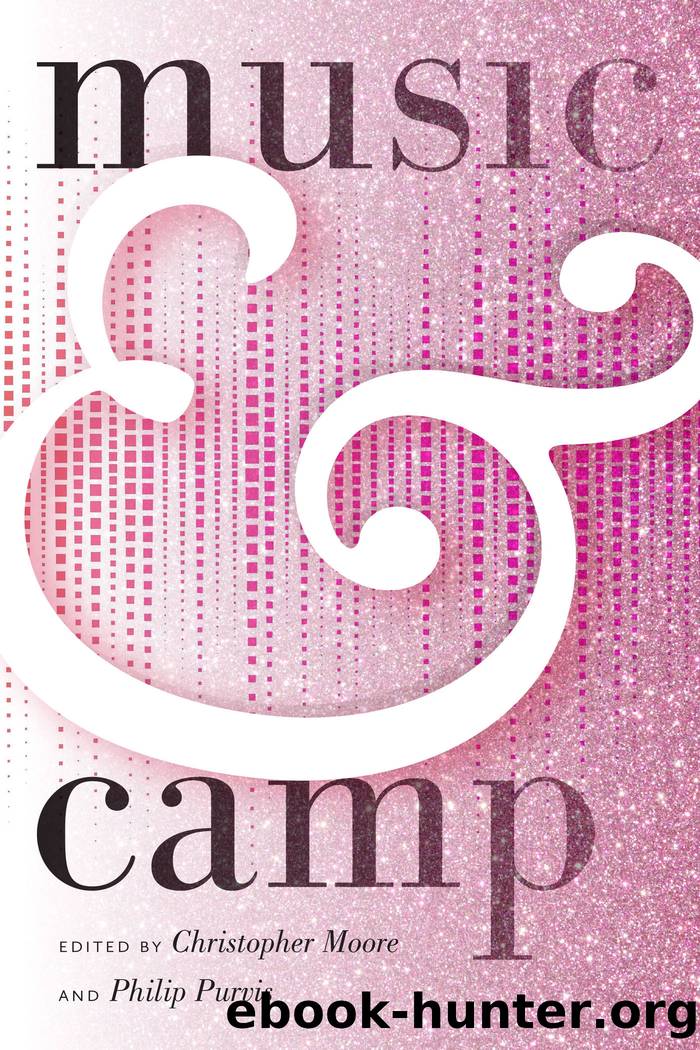Music & Camp by Unknown

Author:Unknown
Language: eng
Format: epub
Publisher: Wesleyan University Press
Published: 2018-03-14T16:00:00+00:00
FRANCESCA T. ROYSTER
8. âThe Booty Donât Lieâ and Other Camp Truths in the Performances of Janelle Monáe
In Susan Sontagâs landmark essay âNotes on âCampââ (1964), she insists that camp as a sensibility is necessarily distanced, disengaged, and nonpolitical, even as it has become a tool of creativity for marginalized gay cultures.1 More recently, filmmaker and writer Bruce LaBruce has provided a rebuttal to Sontag, suggesting that âCamp was always a kind of signifying practice invented out of necessity (both for survival and for sheer pleasure) by âqueerâ (in the classic sense) outsidersâfags, drag queens, transsexuals, deviants, sexual renegadesâand that it was always by its very nature deeply politically committed.â2 Indeed, Christopher Isherwoodâs evocation of campâs seriousness in The World in the Evening confirms the deep investment that many subjects (here, gay male subjects) have in their camp. He writes, âYou canât camp about something that you donât take seriously. Youâre not making fun of it; youâre making fun out of it. Youâre expressing whatâs basically serious to you in terms of fun and artifice and elegance.â3
For African-American alt-diva Janelle Monáe, the extravagance, artifice, outsized theatricality, and especially the serious fun of camp become tools for the political critique of racism, sexism, and social engagement, even while negotiating conventional ways of performing âsincerityâ and authenticity encoded in much commercial soul and R&B musical performance associated with African-American femininity. In my analysis of Janelle Monáeâs negotiations of so-called authentic performances of black femininity, Iâd like to turn to the formulation of ârealnessâ offered up in Jennie Livingstonâs powerful if controversial documentary of black and Latino gay and transgender ballroom culture and identity, Paris Is Burning (1990). In the filmâs voguing competitions, subjects compete under categories such as âBanjee Girl Realness,â a performance of black working-class feminine authenticity (âSheâs on the bus stop on the way to pick up her baby brother at school, that kind of realness,â one of the judges explains) and âexecutive realness,â meaning the ability to pass as employed at a white-collar job. In these competitions, careful attention is paid to clothing brands, makeup and accessories, hair, posture, and hand gestures. This very work both exposes the lie of the truth of realness, and the deep desire and skill put into its convincing production. As the film illustrates, in ballroom culture, ârealnessâ is about passing, about capturing powerful performances of gender, race, and also class, in order to âmake it.â House mother Pepper LaBeija puts it bluntly: âTo be able to blend, thatâs what realness isâ¦. Itâs really a case of going back into the closet ⦠Give the society what they want to see.â4
In her response that followed the film, critic bell hooks accused Livingston of treating these struggles as camp in its most distanced and disengaged sense.5 Yet Iâd argue that the film leaves room for our understanding of the struggle for ârealnessâ as a resistant, creative, and imaginative act. As Livingston exposes the work that it takes to produce the ârealâ and gestures toward the potential of its commodification (particularly in her treatment of model Octavia St.
Download
This site does not store any files on its server. We only index and link to content provided by other sites. Please contact the content providers to delete copyright contents if any and email us, we'll remove relevant links or contents immediately.
Kathy Andrews Collection by Kathy Andrews(11731)
The remains of the day by Kazuo Ishiguro(8828)
Paper Towns by Green John(5092)
Spare by Prince Harry The Duke of Sussex(5074)
Industrial Automation from Scratch: A hands-on guide to using sensors, actuators, PLCs, HMIs, and SCADA to automate industrial processes by Olushola Akande(4986)
The Body: A Guide for Occupants by Bill Bryson(4975)
Machine Learning at Scale with H2O by Gregory Keys | David Whiting(4190)
Be in a Treehouse by Pete Nelson(3952)
Never by Ken Follett(3796)
Harry Potter and the Goblet Of Fire by J.K. Rowling(3775)
Goodbye Paradise(3729)
Into Thin Air by Jon Krakauer(3313)
The Remains of the Day by Kazuo Ishiguro(3295)
The Cellar by Natasha Preston(3262)
The Genius of Japanese Carpentry by Azby Brown(3226)
Fairy Tale by Stephen King(3220)
120 Days of Sodom by Marquis de Sade(3184)
The Man Who Died Twice by Richard Osman(2997)
Drawing Shortcuts: Developing Quick Drawing Skills Using Today's Technology by Leggitt Jim(2996)
